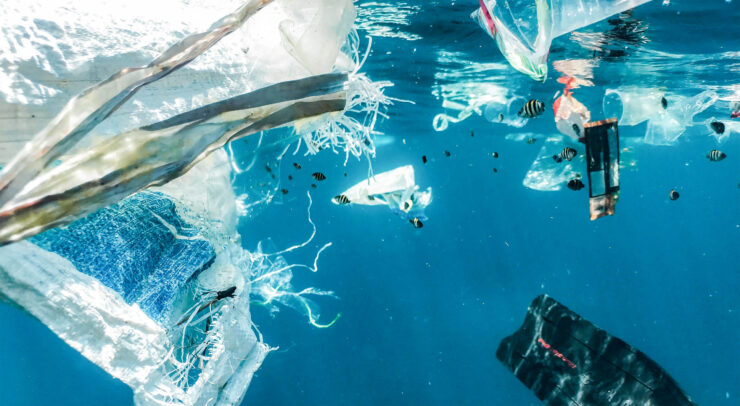PLASTIC BEACH
The conversation around plastic pollution is not an uncommon one. Slowly, governments are adopting measures to ban single use plastics, grocery stores are switching to paper bags, and you would be lucky to find a plastic straw at any dining establishment nowadays.
To better understand the effects nanoplastics and other contaminants like flame retardants may exhibit on the environment, the Fulcrum spoke with U of O professor Jan Mennigen. Alongside his honours students Raphael Chakal and Tyler Eng as well as intra- and extramural collaborators, Mennigen recently published a multidisciplinary study titled “Metabolic Consequences of Developmental Exposure to Polystyrene Nanoplastics, the Flame Retardant BDE-47 and Their Combination in Zebrafish.”
What are polystyrene nanoplastics (PS) and flame retardants (BDE-47)?
According to Mennigen, “Polystyrene is just one group of different plastics that we study. There are also other plastics such as polyethylenes, but the common denominator is that they’re broken down and then transported to virtually all life on earth which may then be affected by these.”
He continued, “The further breakdown of these plastics into either microplastics or nanoplastics becomes important, because they’re now found ubiquitously and as you can imagine in our marine ecosystems, which also changes how they’re distributed in the environment; how they may affect organisms and their toxic properties.”
Flame retardants, also referred to as BDE-47, are types of long-lasting inert compounds — inert meaning chemically non-reactive, which would be their desired effect in order to produce chemically non-reactive upholstery.
These persistent chemicals are often observed in the context of toxicology because of their appearance in water systems. There are also rising concerns of bioaccumulation. As Mennigen explained, larger plastics, such as single-use plastics, are being ingested, which is a cause for concern. However, perhaps more concerning are the smaller plastic particles could be entering the cells of the organisms more passively and readily by either water intake or gill filtration pathways.
Another interesting aspect to consider is the interaction between both nanoplastics and flame retardants, and if one could act as a vehicle for another and thus magnify the effects compared to the independent effects of each compound.
How are these compounds broken down?
In terms of chemical breakdown, consider the great pacific garbage patch which is rapidly accumulating more and more plastic. As the plastics float on the surface of the ocean, Mennigen explained that the breakdown of these plastics into smaller molecules is caused by weathering processes.
Earlier issues within the field were the difficulties in estimating how many smaller breakdown particles existed and how to mimic what’s occurring in the environment in a lab setting.
To answer this question, Mennigen responded, “For BDE-47, we have really good indication of environmentally relevant levels because it’s a legacy contaminant, and as the name indicates, they’ve been around for a long time. They end up mostly on the Stockholm Convention list because they’re very recalcitrant, they don’t degrade well, [and] we know they’re toxic. As a result, we have a really good monitoring program and we know these types of concentrations quite reliably from great lakes studies.”
For the plastics and especially the smaller particles at the time Mennigen began their research by using a range, starting with the lower end of what was believed which was 2.5 parts per million to 25 parts per million. As it turns out in previously studied polar regions there are different types of plastics, polystyrenes, polyethylenes available which do fall into that range.
“Now technology has advanced to the extent that we can analytically quantify it in terms of replicability, so that is one aspect of how we chose these types of exposure concentrations. One thing that we didn’t consider [is that there] is a bit of a technical limitation as well and is important for when we make these inferences about what really happens in the environment is the shape of the particle as well,” said Mennigen.
Most commonly, researchers use polystyrene because they’re readily and commercially available. In addition, they can be fluorescently labelled, which is convenient for Mennigen to see if they were ingested, where they ended up, and if they were found in the intestinal tract. However, since these particles are spherical and not different in terms of their breakdown, they don’t represent the environment as accurately because it is not a homogeneous mixture in terms of breakdown products.
The environment is varied, and perhaps there exist breakdown products that are more rugged, which could change their behaviour compared to the commercially available polystyrene.
The shift to zebrafish
According to Mennigen, there’s been a shift occurring within the toxicological sciences to move away from animal use, since zebrafish embryos are not regulated in early life stages but can still be considered an integrated organism. In line with animal ethics, they are a more attractive model to substitute with some more higher-end organisms. Due to their small size, well-known genome, and the fact that they are a vertebrate aquatic species, researchers can use them to test hypotheses regarding both ecotoxicological health, wildlife health, and potentially human health.
Advancement in technology allows researchers to measure at much finer scales things like oxygen consumption, which is linked to energy balance, or even feed intake in larvae with the use of fluorescent assays. Mennigen also referenced metabolic assays, where researchers can look at how much energy is stored in the forms of neutral lipids or adipose tissue.
“Since these essays are now quite readily available, we can use them comprehensively in this early model to get a good picture of the overall indices of organismal energy balance and to see what the consequences are of the exposure to both nanoplastics and BDE-47,” he explained.
What were the results?
As indicated in their study, there were two questions they were looking to determine: the first is if the acute developmental exposure to PS or environmental levels of BDE-47 alone disrupts larval energy metabolism and secondly, if their mixture will exacerbate metabolic disruption.
Starting with nanoplastics, “the findings were essentially showing that zebrafish use more oxygen when exposed, which is in line with potential higher energy use maybe for detoxification. We also found that they tried to compensate for higher energy use by increasing dietary intake. Mechanistically we’re unsure if it’s linked to the physical blocking the absorption of the intestine, we suspect it is because we could also detect these plastics or these nanoplastics in the intestinal tract using fluorescent labelling.”
For BDE-47, it was less pronounced. They were also exposed to a lower concentration, so very realistic concentration. So, it’s an order of magnitude lower meaning, parts per trillion rather than parts per billion, which are the plastic concentrations. Thus, they found similar effects on oxygen uptake which would indicate that it’s an energetically costly process to be exposed to BDE-47, however, less of a response in other parameters comparatively.
In terms of their combined effect, Mennigen said, “We found these parameters were essentially exacerbated. Therefore, we saw higher oxygen consumption and increased compensation via food intake meaning, they upped the food intake even more. Together, they were the only group to elicit metabolite changes.”
Most interestingly, researchers saw that there were less lipid reserves in the zebrafish. Meaning, less nutrient lipids were stored and they dug into the energy reserves like yolk sacks that they have early on to be used as energy for development, indicating there are additive effects in this early life stage.
Although researchers did not find any overt consequences in terms of crude measurements in growth either in length or weight due to the fact that this study was conducted in the short term. This opens up additional important questions regarding long-term developmental effects and consequences.
As previously mentioned, there might be physical interaction between nanoplastics and BDE-47 and in the presence of more BDE that absorbs into the nanoplastics, and is transported via ingestion, could explain the increased amounts found in the organism. Thus, speaking to the types of synergistic effects that we can see biologically. Moving forward, researchers are hoping to measure how much physical interaction there is between the zebrafish and the water columns.
“It’s important not only to understand potential interaction because we’re always in a sea of contaminants and it’s never just one contaminant at a time. There are legacy contaminants that are old, and they can be maybe re-mobilized by these newer contaminants at a larger scale like nanoplastics, that make them maybe more accessible for these organisms and enrich them and bioaccumulate them further,” said Mennigen.
For those interested in learning more about Mennigen’s research you can visit his website here.






